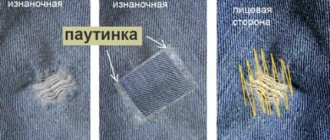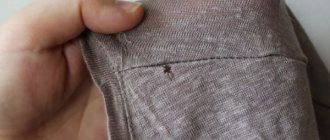Share on social media networks:
Tears in clothes bring no joy to anyone. If you suddenly burn a cigarette or your down jacket is torn, the question immediately arises: what to do? If there was a cut on the sleeve of your favorite jacket from somewhere or a cigarette butt fell onto the collar from the neighbor’s balcony? I really don’t want to throw away good, albeit slightly damaged, clothes, and not every city has a workshop. There is only one way out - try to quietly repair the thing with your own hands. You will learn how to repair and remove a hole in a down jacket from our article.
Inspecting the clothes
Damage, as you know, can be different. With some you can cope without much difficulty, with others you will have to tinker and show a fair amount of ingenuity.
Before you fix a hole in a down jacket, carefully inspect the item and soberly assess the size of the disaster. There are gaps:
- in the form of straight cuts;
- in the form of cuts with a small frayed hole at the end;
- in the form of a scorch mark with a small hole;
- in the form of a hole with smooth or uneven edges.
A straight cut most often occurs where the tissue has simply burst. Perhaps there was a crease or fold in this place. This is the simplest case, regardless of the location of the damage. The gluing area, if you do everything carefully, will be invisible in any case.
It's much worse if you hit a nail, resulting in a “laceration” plus a relatively smooth tear. In this case, a lot depends on the location, and you will have to act in one of two ways:
- in an inconspicuous place - sew or tape;
- if the hole is clearly visible, you will have to disguise it.
Important! Holes with smooth and uneven edges, as well as scorch marks, can also be eliminated in two ways - patching and appliqué.
Types of holes on a jacket
Winter and demi-season clothing, unlike a shirt or trousers, has a top layer, which is most often damaged, and an insulating lining with filling. The resulting defects on the product can be of the following types:
- A cut. This could be a knife blade, glass or any other sharp object.
- Burnout. It is formed due to thermal or chemical effects on polyester, melting it.
- Hook. Formed when interacting with objects, leaving a torn area.
If the damage is located in a less noticeable place - for example, a pocket, armpit, side seam or bottom of the product, then it is better to sew up or seal such holes. If an unpleasant hole is located in a visible place, it should be disguised using patches or stripes.
Making patches
To eliminate a defect in a product, you can mend the damaged area, glue it, or use a decorative patch. To understand how to repair a hole in a down jacket, you need to know the composition of bolonium for gluing. Before starting the process, you should carefully study the jacket labels
, which describes the effects of temperature and agents when processing fabric.
Darning is not always appropriate for jackets with a feather or down base, since the outer material is very thin, and due to impregnations it has a certain density. Closing a hole in this way can lead to the formation of a sloppy seam.
To make patches, it is advisable to choose a material identical to the composition and color scheme of bologna in order to avoid melting and deformation of the fabric. The patch for the hole is cut out slightly larger than the required size. Its shape can be varied - from the usual squares and stripes to shapes in the form of fruits, smiley faces, etc.
Patches and accessories for decorating defects
Eliminating holes in jackets is possible with the help of stripes, but they must be used in those parts of the product where they are appropriate. Using embroidery as a separate element, for example, a company logo or a thematic image, is better on the sleeves, front of the product or in the pocket area.
In this case, the patch pattern should be selected in accordance with the color and size. In stores you can find such emblems with adhesive coating on the reverse side
, which is attached to the site of damage using a thermal method. The process takes place using an iron; in addition, you can manually sew the part to the defect site, masking it.
If the cut is long and narrow, decorative or reflective tape is used to hide the defect. Having cut off a piece corresponding to the length, attach it to the damaged part using glue or heat-shrinkable web.
You can decorate the area using metal or plastic fittings, then the repair site will be invisible. Depending on the appropriateness of the use of parts, these may be:
- A row of buttons.
- Making eyelets in place of the hole.
- Installation of buttons or rivets.
- Decorative braid.
The fittings can be installed at home, and the necessary parts can be purchased at the nearest fabric store. If the installation is difficult, the product can be taken to a specialist for repair.
Preparing materials and tools
If you are wondering how to seal a down jacket at home, prepare the necessary materials and tools. You may find it useful:
- a piece of fabric from a down jacket;
- a piece of fabric of the same color and similar quality;
- a piece of fabric with an adhesive layer;
- glue;
- threads in the color of the fabric;
- sewing supplies;
- tweezers;
- labels or stickers, buttons, short zippers.
Where can I get fabric for a patch?
Before you seal the hole on the down jacket, try to remember whether there was a scrap of the same fabric in the plastic bag that is attached to the label. Unfortunately, now some manufacturers do not consider it necessary to sell their products with pieces of the same fabric, but sometimes this is still done periodically.
If there was no scrap or you cannot find it, well, you will have to get out of the situation in other ways. Choose a material that is similar in color and quality.
Important! It is not necessary to buy a whole piece - you can look at the store for kits for beginner needlewomen; they often have scraps, including some that are suitable for your purposes.
A very good option is fabric with an adhesive layer. Unfortunately, it is not always possible to match it by color, but sometimes it is possible. In this case, you won't need glue.
Important! In a completely hopeless situation, when no material at hand even comes close, you can take a small piece from the jacket itself, from an inconspicuous place (for example, cut off from the inside of a pocket).
If, after a thorough examination of the defect, you understand that it is unlikely that anything can be done about it, you will definitely be interested in our articles:
- Rating of down jackets by quality;
- Which down jacket style should you choose?
Glue
How to repair a cut on a down jacket if you can’t sew it up? You need glue, of course, but not just any glue. PVA is completely useless in this situation. You can easily find a suitable composition. Suitable for down jacket repair:
- rubber;
- “Moment 88” or “Crystal”;
- "Second";
- acrylic.
Important! The glue must be colorless!
Repairing the cut
An even cut is the most harmless option. It can be eliminated in two ways:
- sew up;
- seal.
Sew up
How to sew up a hole in a down jacket? Like any other long hole with smooth edges. Can be used:
- hand stitch;
- Zigzag machine stitch.
Important! This option is possible if there are threads that perfectly match the color of the fabric or stitch, and the cut itself is not in the most noticeable place.
Option 1:
- Thread the thread through a regular needle so that one end is longer than the other.
- Tie a knot at the long end.
- Bring the needle out from the wrong side to the end of the cut.
- Make several cross stitches very close to each other, catching both edges of the cut.
- Sew up the main part of the hole with a goat seam, using small stitches, placing them almost closely.
- At the other end of the cut, make several cross stitches in the same way as at the beginning.
- Fasten the thread and hide the end under the stitches.
Option 2
If you have a sewing machine (any type), simply sew a zigzag stitch around the cut area, and bring the ends of the thread to the wrong side and fasten.
Important! If the cut appears in a visible place, but it can only be sewn up, make a symmetrical imitation on the other side.
Seal the cut
If you are deciding how to fix a cut on a down jacket, but you don’t know how to sew at all, well, you’ll have to eliminate the flaw with glue. Moreover, getting rid of an even cut is the easiest way.
Important! It is not at all necessary to look for fabric of the same color as the down jacket - you will be quite satisfied with braid, crepe or satin ribbon.
Let's start repairing the down jacket with our own hands:
- Cut a piece of fabric that is similar in color and quality - it should be a strip about 1 cm longer than the cut.
- Coat the front side of the strip with glue.
- Insert it into the cut and straighten it - the edges of the strip should extend beyond the ends of the hole.
- Align the edges of the cut.
- Press the parts tightly together (you can place an iron on top, but you don’t need to turn it on).
Important! It is best to insert the flap under the main layer using tweezers.
No methods help at all? Dont be upset!
Unleash your creativity with our helpful tips to get a completely new item with an interesting design. Check out the step-by-step master class on how to make a vest from a jacket at home.
How to sew a down jacket near the seam
If the jacket is torn at the seam, there is no need to invent anything. Such a hole can be sewn up with thread. First, it is recommended to visit a haberdashery store that sells suitable threads.
It should be noted that such a gap can be eliminated even without a sewing machine. To make sewing more convenient, the jacket must be placed on the table, first turned inside out. It is important to sew so that the new line is a continuation of the old one. In this case, the seam should be as smooth as possible.
It is most difficult to sew up seams if the jacket has a lining. To make your task easier, you should make a small cut on the inside, which will also need to be stitched up.
Hole with jagged edges
Repairing a down jacket with your own hands will take a little longer if there is a hole with uneven edges. The hole can only be repaired using a patch:
- Trim the uneven edges of the hole to make them even.
- Remove frayed threads.
- Remove excess fluff (the easiest way to do this is with ordinary tape - fluff sticks to it perfectly).
- Cut a patch that is slightly larger than the hole.
- Apply glue to the edges of the patch.
- Let the glue dry a little.
- Push the patch into the hole.
- Glue it from the inside and straighten it.
- Press the parts with a heavy object on top.
- Leave the glue to dry - this will take about six hours.
Important! Apply glue to the front side of the patch.
Fabric with adhesive backing
You can answer the question of how to repair a torn down jacket at home at a craft store. They sell fabric with an adhesive base. If the edges of the hole are aligned, you can't think of anything better. There is no need to trim the edges, just cut out a patch that is larger in size than the hole, and then:
- Place the patch under the base layer with the adhesive layer facing up.
- Spread the edges of the hole so they touch.
- Iron the entire structure with a hot iron.
Creative approach to renovation
When eliminating a hole from any damage, you should use your imagination. It all depends on the location of the flaw. For example, if a tear in the material occurs in the chest area, you can use decorative stripes. And if there are pockets with zippers, disguise the cut with a short zipper.
When creating holes at the elbows of things, it is important to maintain symmetry
and put the patch on the other sleeve. If the fabric is damaged on the back of the yoke, you can put a large patch the size of the part; in this case, gluing is not necessary, just carefully cut the fabric to size and sew it manually with a blind seam to the product. Or use a sewing machine and stitch along the face.
For children's products, an option on how to sew up a jacket would be to make patches in the form of cars, hearts, flowers or geometric shapes. Or collect knitted braid in the form of a bow, a flower, and with this voluminous composition cover the area of the flaw.
Attention, TODAY only!
Down jackets have become an indispensable element of insulated clothing for the winter period. During use, the fabric may become damaged from cuts, cigarettes, or snags. The appearance of the product deteriorates instantly, especially if the hole is in a visible place. Find out how to correct the situation in this article.
Damage to the fabric surface of the product can occur in many cases. In this situation, it is not necessary to contact the studio. With a few skills and helpful tips, holes and cuts can be carefully repaired with your own hands.
Key ways:
- glue;
- make a patch;
- sew up.
Before carrying out repairs, it is necessary to prepare tools.
They are prepared depending on the chosen method.
Tools:
- fabric for a patch to match the product;
- threads to match the product;
- needle;
- sewing glue;
- scissors.
Now you can take a closer look at the work process.
Sew up carefully
First of all, you need to pay attention to the damage itself. If the hole is small, with smooth edges, it can be picked up with threads.
In order to sew up a cut or hole, it is necessary to treat the damage itself.
Carefully trim any protruding threads. If the hole is caused by a cigarette, you must carefully cut off the area where the tissue was burned. For greater convenience, you can use small nail scissors.
When the edges are processed, you can proceed directly to work.
To do this, we will need threads to match the product.
If you couldn’t find any, you need to use a shade that best matches the color of the down jacket. The seam can be laid either from the outside or from the inside, depending on personal requirements.
If the stitches will be located on the outside of the product, you must carefully sew the damaged area with a zigzag seam. A few stitches will be enough for this.
In the case of an internal seam
the process is somewhat more complicated. First, we remove the damaged edges. Then, from the wrong side, carefully rip the down jacket and find the place of damage. Slightly bending the edges, sew with a small stitch. When the work is finished, we sew together the previously opened wrong side. The down jacket is repaired.
Reference!
When sewing externally, you can also use a loop stitch (in the shape of the letter P), which is applied with small stitches.
Cover it up discreetly
Bonding damaged tissue has a similar process.
If a hole appears when the fabric is burned, carefully cut off the damaged edge. Lightly grease the material with special fabric glue, carefully fold it inward and glue it together. In most cases, it is recommended to leave the product for several hours to wait until the glue has completely dried.
Many needlewomen go a different route. If damage or scorching appears on the shelves, pockets or sleeves, they are repaired with various applications. Any drawing is suitable for this, depending on personal preferences or hobbies. The application is best used with a special adhesive layer
m. This process is characterized by simple steps and a minimum amount of time.
Making a patch
In most products, manufacturers include an additional piece of fabric with the down jacket. It is intended to test the product before washing or is used as a patch. If there is no spare material, the situation is somewhat more complicated. You can find a scrap that is as close as possible in color and structure to the color of the down jacket. If this was not possible, if both sides of the down jacket match, you can carefully cut off a small piece from the inside of the product (for example, the lining).
Reference!
Additional scraps can be found at specialty craft stores. For greater convenience, you should buy fabric with an adhesive base.
The best option would be to glue a patch.
To do this, carefully process the uneven edges and cut out a small piece from the scrap that is identical to the damage. Lubricate the underside of the patch with glue and carefully press it onto the torn part. For a more reliable fixation, you can place a heavy object on top and leave it for several hours.
With a few simple steps, the patch is ready.
- When gluing a patch, it is better to use tweezers for more comfortable work.
- It is necessary to use only transparent and waterproof glue suitable for working with fabric materials.
- When correcting a patch with uneven edges, it is recommended to first trim the edges to make them smooth.
- When using stickers and appliqués, you must first sew up the scorch mark. This will help prevent the fabric from unraveling in the future.
- You can use a sewing machine to sew a zigzag seam.
- It is recommended to select applications and stickers in accordance with the style of the product. For a classic down jacket - flowers or bright designs, for sports models - badges or symbols of popular youth brands.
Conclusion
Every person regularly experiences damage to their clothing. Particularly disappointing are holes and cuts in winter clothing such as a down jacket. With a few simple skills and our helpful tips, you can fix most holes yourself at home.
Stickers and applique
How to patch a down jacket if the hole is too big? There is no other way out except to disguise it with some decorative element. The patch itself is done in any convenient way. It can be:
- stick;
- sew on.
Important! Since there will be decoration on top, it doesn’t matter what the patch itself looks like. The hole can be sealed in the same way as a small hole with smooth edges, and covered with a decorative element on top, but you can also make a classic patch.
Preparation
First, the applique and the down jacket itself must be prepared:
- Choose a sticker with embroidery or applique that is suitable in shape and size - it should completely cover the hole.
- Prepare the hole itself too - trim the edges, cut off excess threads
- Baste the decorative patch along the edge using a basting stitch.
- Sew the element.
Design ideas
Despite the fact that stickers and chevrons can now be seen on almost any part of the body, there are still places on clothing where they will not look very good. It will become clear to everyone you meet that the sticker is not a tribute to fashion at all, but hides something. In this case, it is better to mask the holes with other elements.
In general, a “repair kit” can be assembled from anything. Look what you have:
- Velcro;
- eyelets;
- reflective tape;
- braid;
- metal or plastic buttons.
Braid
Braid, unlike stickers, will look stylish anywhere. For example, on the floors, if one of them is damaged, you can sew two symmetrical “patches”, that is, two pieces of braid.
Important! Such stripes can be arranged crosswise or in the form of some kind of pattern - in short, there are plenty of options. The braid can be of different widths, matching the jacket or contrasting.
Reflective tape
Fashionable and very comfortable item. With its help, you can kill two birds with one stone - disguise the hole and make your clothes more compliant with safety rules in the city.
Important! You can sew it however you like - just on a hole, in different places throughout the down jacket - or even around the perimeter.
Short zipper
If you have a long hole with relatively smooth edges on the sleeve, chest or hem, you can put a short zipper to match. There may be one, but nothing prevents you from creating symmetry.
Important! There are other options - for example, pieces of fabric with buttons stuffed on them.
Features of the material of manufacture
When offering fabrics for the top of a down jacket, developers try to ensure that it is functional, protects from wind and cold, and has water-repellent properties. The most commonly used are synthetic, mixed and natural fabrics.
Bologna
Bolognese is a synthetic linen material for the manufacture of outerwear with waterproof properties. The advantages of the material include:
- strength;
- practicality to wear;
- ease;
- maintaining shape;
- high water-repellent properties;
- aesthetic appearance.
Among the disadvantages:
- poor breathability;
- high possibility of rupture if caught on a sharp object;
- ability to melt when exposed to high temperatures or open fire.
Polyester
This is one of the most common synthetic fabrics, used both in pure form and in mixtures with other materials. The advantages of polyester include:
- ease of care;
- machine washable;
- no deformation when worn;
- heat resistance;
- high water-repellent properties.
Polyester can form folds and creases that cannot be smoothed out. The qualities of polyester are significantly improved when mixed with polyamide, spandex or cotton. When repairing down jackets with a polyester coating, experts recommend not applying patches, but gluing thermal decals or using a special glue to restore damage.
Natural fabrics
Fabrics of plant, mineral or animal origin are called natural. These include cotton, linen, silk, leather and wool. Cotton or its combinations with natural or synthetic fibers are often used for jacket coverings.
Natural fabrics have a number of undeniable advantages:
- antiseptic and hypoallergenic properties;
- comfortable wearing conditions;
- hygroscopicity;
- strength;
- good thermoregulation and ventilation.
See also
Step-by-step instructions on how and what is the best way to seal a soccer ball
Disadvantages include the possibility of color loss, wear, creasing, and shrinkage after washing.











